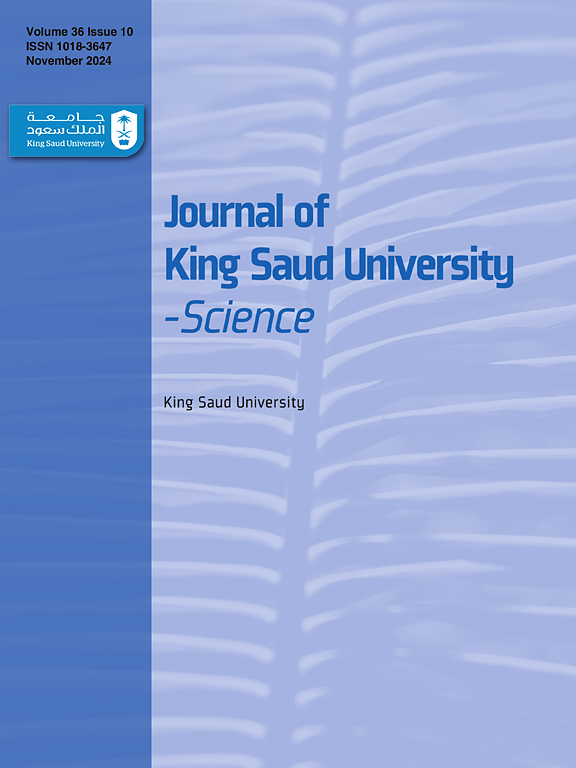Prevalence and antibiogram pattern of multidrug-resistant Staphylococcus aureus infections in individuals with sickle cell disease. A retrospective study, hematological and genetic analysis
IF 3.6
3区 综合性期刊
Q1 MULTIDISCIPLINARY SCIENCES
引用次数: 0
Abstract
The prevalence of Staphylococcus aureus in the circulation (bacteremia) of individuals with sickle cell disease (SCD) may provide a substantial risk for illness and death. Strains of S. aureus exhibit a wide variety of virulence traits, including the ability to generate various toxins and develop treatment resistance. MRSA is characterized by its resistance to a range of beta-lactam antibiotics. This study’s objectives included assessing the frequency of S. aureus infection in SCA patients, analyzing laboratory markers of the CBC test, examining the antibiotic susceptibility pattern, and investigating the mecA gene and heteroresistance, which could potentially link to a higher occurrence of S. aureus infection in SCA patients. The retrospective study was done to gather clinical data on individuals with sickle cell anemia (SCA) who had bloodstream infections. From 2017 to 2021, blood samples and data were gathered by King Saud University Medical City (KSUMC) in Riyadh, Saudi Arabia. The S. aureus strains were re-cultivation, Vitek system and PCR techniques were employed to ascertain the antibiotic resistance patterns. It was confirmed that 2406 patients with SCD had contracted an infection. A total of 138 (5.73 %) patients with SCD were diagnosed with bacteremia. “Of the 138 strains isolated, the MRSA strain revealed as the most prevailing, including 30 isolates (21.7 %), whereas non-MRSA strains constituted 17 isolates (12.3 %).” Males had a higher rate of infection compared to females. The results indicated that all the S. aureus isolates exhibited resistance to ampicillin, while the resistance to penicillin was 98 %. Furthermore, the results indicated that over 65 % of the isolates exhibited resistance to amoxicillin, amoxicillin, cefazolin, imipenem, and oxacillin. The mecA gene was identified in all S. aureus strains obtained from patients with SCD. The current study recognizes the PCR assay as a more dependable technique for assessing antibiotic resistances, in contrast to the Vitek method. A study found strong links between S. aureus infections in individuals with SCD and three different factors: hemoglobin (Hb) level, mean corpuscular volume (RDW), and white blood cell (WBC) count (p < 0.004, 0.005, and 0.02, respectively). The study revealed that 34 % of the S. aureus strains that were examined exhibited heteroresistance to the mecA gene as well as resistance to oxacillin. The results clearly demonstrated that Ampicillin, Penicillin, amoxicillin, cefazolin, imipenem, and oxacillin are unsuitable choices for the treatment of blood infections in individuals with SCD. “The findings of this study confirmed that all S. aureus isolates were sensitive to gentamicin, and more than 80 % of the isolates were sensitive to ciprofloxacin, moxifloxacin, levofloxacin, clindamycin, and vancomycin.” Further investigation is necessary to explore potential factors that increase the susceptibility of individuals with SCD to bacteremia caused by antibiotic-resistant strains of S. aureus.
镰状细胞病患者耐多药金黄色葡萄球菌感染的流行率和抗生素图谱模式。回顾性研究、血液学和遗传学分析
镰状细胞病(SCD)患者血液循环(菌血症)中普遍存在的金黄色葡萄球菌可能会带来巨大的疾病和死亡风险。金黄色葡萄球菌菌株表现出多种毒力特征,包括产生各种毒素和产生耐药性的能力。MRSA 的特点是对β-内酰胺类抗生素具有耐药性。本研究的目标包括评估 SCA 患者感染金黄色葡萄球菌的频率、分析 CBC 检验的实验室指标、检查抗生素敏感性模式、调查 mecA 基因和异抗性,这可能与 SCA 患者感染金黄色葡萄球菌的发生率较高有关。这项回顾性研究旨在收集镰状细胞性贫血(SCA)患者发生血流感染的临床数据。从 2017 年到 2021 年,沙特阿拉伯利雅得的沙特国王大学医疗城(KSUMC)收集了血液样本和数据。通过重新培养金黄色葡萄球菌菌株、Vitek 系统和 PCR 技术来确定抗生素耐药性模式。经证实,2406 名 SCD 患者感染了金黄色葡萄球菌。共有 138 名(5.73%)SCD 患者被诊断为菌血症。"在分离出的138株菌株中,MRSA菌株最多,包括30株(21.7%),而非MRSA菌株占17株(12.3%)"。男性的感染率高于女性。结果表明,所有分离出的金黄色葡萄球菌都对氨苄西林有抗药性,而对青霉素的抗药性为 98%。此外,结果表明,超过 65% 的分离菌株对阿莫西林、阿莫西林、头孢唑啉、亚胺培南和奥沙西林具有耐药性。在从 SCD 患者体内获得的所有金黄色葡萄球菌菌株中都发现了 mecA 基因。与 Vitek 方法相比,目前的研究认为 PCR 检测是一种更可靠的抗生素耐药性评估技术。一项研究发现,SCD 患者的金黄色葡萄球菌感染与血红蛋白 (Hb) 水平、平均血球容积 (RDW) 和白细胞 (WBC) 计数这三个不同因素之间存在密切联系(p 分别为 0.004、0.005 和 0.02)。研究显示,34% 的金黄色葡萄球菌菌株对 mecA 基因表现出异抗性,并对奥沙西林产生抗药性。研究结果清楚地表明,氨苄西林、青霉素、阿莫西林、头孢唑啉、亚胺培南和奥沙西林都不适合用于治疗 SCD 患者的血液感染。"本研究结果证实,所有金黄色葡萄球菌分离株都对庆大霉素敏感,80%以上的分离株对环丙沙星、莫西沙星、左氧氟沙星、克林霉素和万古霉素敏感"。"有必要进行进一步调查,以探究增加 SCD 患者对金黄色葡萄球菌耐抗生素菌株引起的菌血症敏感性的潜在因素。
本文章由计算机程序翻译,如有差异,请以英文原文为准。
求助全文
约1分钟内获得全文
求助全文
来源期刊

Journal of King Saud University - Science
Multidisciplinary-Multidisciplinary
CiteScore
7.20
自引率
2.60%
发文量
642
审稿时长
49 days
期刊介绍:
Journal of King Saud University – Science is an official refereed publication of King Saud University and the publishing services is provided by Elsevier. It publishes peer-reviewed research articles in the fields of physics, astronomy, mathematics, statistics, chemistry, biochemistry, earth sciences, life and environmental sciences on the basis of scientific originality and interdisciplinary interest. It is devoted primarily to research papers but short communications, reviews and book reviews are also included. The editorial board and associated editors, composed of prominent scientists from around the world, are representative of the disciplines covered by the journal.
 求助内容:
求助内容: 应助结果提醒方式:
应助结果提醒方式:


